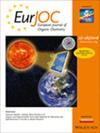从农业废弃物中可持续合成生物源CuO纳米颗粒用于一锅C-N键形成
IF 2.7
3区 化学
Q2 CHEMISTRY, ORGANIC
引用次数: 0
摘要
我们报道了一种简单、绿色、经济有效的方法来合成氧化铜纳米粒子(CuONPs),使用废棉花壳(WCS)灰提取物作为天然碱(pH值为12),取代传统的无机碱。绿色合成的CuONPs在多相催化中表现出优异的催化活性,促进了C-N键的形成,这是获得各种生物活性氮杂环的关键策略。TEM分析表明,该CuO纳米结构呈球形,平均粒径为15.5 nm。该催化剂通过末端炔和邻苯二胺的环化,有效地促进了喹诺啉衍生物的合成,提供了广泛的底物范围(17种喹诺啉衍生物),良好的收率和可回收性。这种方法也适用于脂肪族末端炔。此外,在室温下,CuONPs还催化了胺与α, β -不饱和化合物的aza - Michael加成反应,获得了优异的收率。该方案允许广泛的胺,包括无环,环(最多七元环),伯胺,仲胺和杂环胺。报道了14种杂化Michael加成产物的合成。此外,CuO纳米结构具有高稳定性和可重复使用性,最多可重复使用5次,并且活性损失最小。本文章由计算机程序翻译,如有差异,请以英文原文为准。
Sustainable Synthesis of Biogenic CuO Nanoparticles from Agro‐Waste for One‐Pot C–N Bond Formation
We report a simple, green, and cost‐effective method for synthesizing copper oxide nanoparticles (CuONPs) using waste cotton shell (WCS) ash extract, which serves as a natural base (pH 12), replacing conventional inorganic bases. The green‐synthesized CuONPs exhibit excellent catalytic activity in heterogenous catalysis facilitating C–N bond formation, a key strategy for accessing various bioactive nitrogen heterocycles. TEM analysis reveals spherical morphology of the CuO nanostructure with an average particle size of 15.5 nm. The catalyst efficiently promotes the synthesis of quinoxaline derivatives via cyclization of terminal alkynes and o‐phenylenediamine, offering broad substrate scope (17 quinoxaline derivatives), good yields, and recyclability. This methodology is also applicable to aliphatic terminal alkynes. Additionally, CuONPs also catalyzed the aza‐Michael addition reactions of amines with α, β‐unsaturated compounds at room temperature, affording excellent yields. The protocol tolerates a wide range of amines, including acyclic, cyclic (up to seven‐membered rings), primary, secondary, and heterocyclic amines. Synthesis of 14 aza Michael addition products are reported. Furthermore, the CuO nanostructures exhibits high stability and reusability for up to five cycles with minimal loss of activity.
求助全文
通过发布文献求助,成功后即可免费获取论文全文。
去求助
来源期刊
CiteScore
5.40
自引率
3.60%
发文量
752
审稿时长
1 months
期刊介绍:
The European Journal of Organic Chemistry (2019 ISI Impact Factor 2.889) publishes Full Papers, Communications, and Minireviews from the entire spectrum of synthetic organic, bioorganic and physical-organic chemistry. It is published on behalf of Chemistry Europe, an association of 16 European chemical societies.
The following journals have been merged to form two leading journals, the European Journal of Organic Chemistry and the European Journal of Inorganic Chemistry:
Liebigs Annalen
Bulletin des Sociétés Chimiques Belges
Bulletin de la Société Chimique de France
Gazzetta Chimica Italiana
Recueil des Travaux Chimiques des Pays-Bas
Anales de Química
Chimika Chronika
Revista Portuguesa de Química
ACH—Models in Chemistry
Polish Journal of Chemistry.

 求助内容:
求助内容: 应助结果提醒方式:
应助结果提醒方式:


